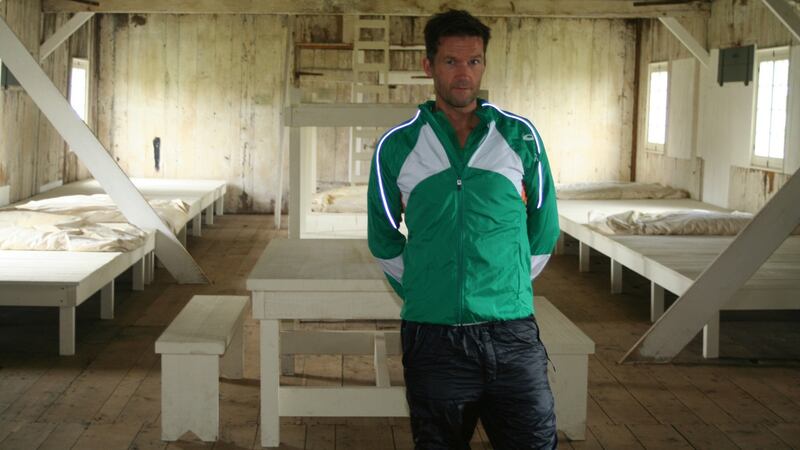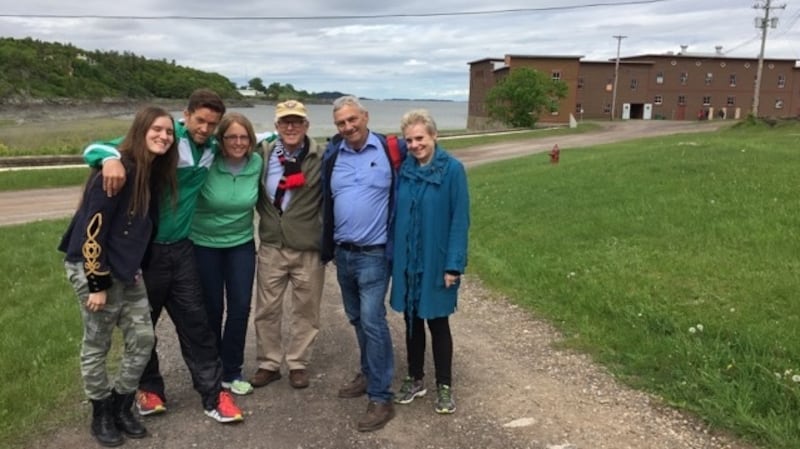[ Irish Diaspora RunOpens in new window ]
The saying goes that all journeys begin with a single step, and at the start of this 900km run the stark simplicity of the saying resonates. I am an ultra-runner, so distance alone should not be daunting, but this Diaspora Run holds a deep personal and historical significance. In the past I ran for my country chasing medals. Now I am running for a greater historical context - to raise awareness of the tragic year of Black ‘47.
In that year, the convergence of British government policies dispossessed more Irish than in any other year of the Great Hunger. Under the directive of a newly elected prime minister, Lord Russell, the British parliament voted to end famine relief, mandating relief be carried out by absentee landlords. To shirk responsibility, landlords began a universal campaign of eviction, thus removing the obligation to feed their tenants.


Suddenly, the Irish hinterland, especially in the provinces of Munster and Connaught, swarmed with a starving army of skeletons. To make matters worse, in America, under the maritime Passenger Act, typhus stricken vessels and ships not adhering to the stricter sanitary rules were barred from entering America.
Under the growing crisis of the dispossessed, the eventual choice was to ship them to Canada, then under British control. In a cruel and desperate measure, emptied lumber-carrying ships returning to Canada were commissioned and hastily retrofitted to carry human ballasts. No regard was given to sanitary conditions or to feeding those who would make the 40-day transatlantic voyage to the eventual entry port at Grosse Île quarantine station, some 30km north of Quebec City.
I am beginning my run from this sobering quarantine station, or more specifically from a parking lot in sight of the island.
The evening before the run I was given a grand tour of Quebec by James Donovan of the Ancient Order of Hibernia, Joe Lonergan of the Irish Heritage Society of Quebec, Fergus Keyes of the Montreal Irish Monument Park Foundation, and Peggie Hopkins, Fergus's partner. Reminiscent of Irish weather, it rained cats and dogs as we shuttled from one site to another.
What I took from the tour was a history of Quebec, but perhaps more so, in quietly observing my hosts, an appreciation of the custodial mantle those associated with history bear in preserving our collective past. A beautiful Celtic cross is situated within the old walls of Quebec across from Saint Patrick’s church. We gathered and had photographs taken by it. The funds for the cross were raised through the dogged determination of those accompanying me that day. James Donovan also coordinates the Saint Patrick’s Day parade and the essence of all things Irish emanates from himself and the quietly dignified Joe Lonergan.
The intersection of varying histories continued. We left the Celtic cross for a tour of the Plains of Abraham. On this site in 1759, the British claimed victory over the French in a battle that took a mere 20 minutes. Here again was the darkening influence and encroachment of British imperialism, but this time the advance of British forces on what was then New France.
I claim no extensive knowledge of the history, but what I gathered in questioning my hosts was that despite the imposition of British rule, somehow Quebec maintained its religion and language. From an Irish perspective, I thought this intriguing. I wanted to understand the political realities and rationale for how the conquest and life after continued without bloodshed. The history has obviously been covered, but it is an anomaly I would like to further explore at some point. The short answer given was that neither the French nor the English wanted control of a region so far north, so the victory and conquest by the British was more a psychological victory than an actual conquest.
I remained dutifully attentive to what I was being shown, but simultaneously my mind was on the visit to Grosse Île but so, too, to the ill-conceived plan to actually begin the first marathon after visiting the island. Sometimes misery and ill-planning have their own merits. I felt, in quietly submitting to a day walking and then socially drinking for much of the night before leaving at the crack of dawn to visit Grosse Île, that I was behaving like an amiable soul mindful of what this committee had so carefully planned in my honour.
So, to the isle of Grosse Île. How strange it was to come upon a Celtic cross looming over the Saint Lawrence against the shimmer of the river. It grew in proportion, occupying the highest point on the island. I had anticipated it, but the starkness and grandeur of the cross harkened to an ancient Celtic spirit. This was home, but re-appropriated in a foreign land. I was mindful that, though we are modern Irish, we are descendants of a Christian and pagan Celtic past. Somehow both histories converged in this cross and I felt it better represented the nativism of a Gaelic peasant experience that was then steeped in both traditions.
When we arrived and climbed to the cross, we then followed a narrow path that served as a gateway to the mass interment of over 5,000 Irish who died of typhus and the results of starvation due to a 40-day passage aboard coffin ships between May and October of 1847.
The glass memorial wall of names figures as one of those indelible moments that brought the stark reality of political policy and systematic tyranny into a roll call of the dead. Here were the victims of whatever history will eventually decide to call the policies of the British during the famine.
Each in our party found a family name and so went the reach of our heart across a span of years to those who were our forebears. If there was reproach and anger in my heart at the catalog of injustices perpetrated on those unfortunates, in standing on Grosse Île, the anger left me. After all the historical research done, nothing prepared me for the actual witnessing of the memorial and the acreage of land that held 5,000 Irish. At that moment, I felt a prayer to the departed was the most dignified and necessary of acts.
Our guide told us that there were no crosses set on the graves until the late 20th century. The history was not forgotten, but lost. Grosse Île is not simply an Irish memorial site, but was the quarantine station and point of entry for all emigrants to Canada. The municipal authorities were mandated to simply care for the sick and the dying, not to memorialize them.
Again, in walking with the associated members of the Irish party accompanying me, I realised how the Celtic Cross and graveyard crosses were erected through the dogged persistence of so many Irish who would not allow their history to go undocumented.
I also saw in observing my hosts, that they shared a psychological point of origin, and perhaps this is what differentiates the diaspora from those who stayed at home. They are more sentimental and fierce in remembering the history of how they ended up in Canada. They cannot recall the past, without contextualizing a history that, again, may seem too far removed for a modern Irish person.
What I can vouch for is their sincerity and perseverance in maintaining their history, not out of a collective anger, but in recognition that this history preceded them and defines their remove from Ireland. They are more exiles than immigrants. This is the tragic sadness and legacy of the Irish immigrant experience. Who can blame them, really? Not I.
We ended our tour of the island at the lazaretto fever sheds where so many of those who had survived the initial passage died from typhus. At the height of emigration in 1947, some 40 ships, carrying over 300 people in each, overwhelmed the medical resources at Grosse Île. The British were aware of the advancing disaster and despite the appeal of administrators on the Canadian side to stave the tide of approaching disease which threatened Quebec and Montreal, the ships kept sailing.
Stark and unpainted, the sheds seemed to capture an 18th century primitivism. One asks - how did anybody survive the Atlantic Crossing, or even these lazaretto fever sheds?
We happened to be shadowing a group of Canadian school children throughout the day on the island, either arriving before or after them at various points of historical interest. They were not Irish. The trip was more related to the history of Grosse Île as a quarantine that processed all immigrants for close to a century.
At the end of the trip we converged with the children. The guide was speaking in French and I approached to listen. The children’s attention was given to a single historical artifact that seemed to capture the tragic loss of life. It was the small shoe of a four-year-old child. The child almost certainly perished, and in scavenging to survive, all clothes on a dead person were taken and worn by survivors. Such was the extremity of poverty and necessity.
The guide conveyed that experts had examined the shoe and determined that it had been re-cobbled and worn by at least three generations of children.
It is strange how a single artifact can somehow endow a greater understanding of a life and time. In the riot of noise that accompanied the Canadian school children, there was a sudden and deferential silence and I understood that our history had been channelled and preserved.
Not long after, I laced up my own running shoes and left unceremoniously from a parking lot in sight of the island. I had the gift of new friends to see me off, and so began the run under threat of advancing rain and gathering clouds. It was how I envisioned it. It was an Irish leave-taking with the urgency of miles ahead and the quiet trepidation of what the journey would hold!
How to join the Irish Diaspora Run
The route begins at Grosse Île quarantine island, on the St Lawrence river, and continues through Quebec City, Montreal and Kingston before reaching Ireland Park, in Toronto.
The project is raising funds for Irish-Canadian organisations seeking to create parks and erect monuments and statues to commemorate 1847.
Others can participate by taking on runs where they live, and logging their distances on diasporarun.org, where they can also sponsor Collins.
This project is supported by the Global Irish Media Fund

















